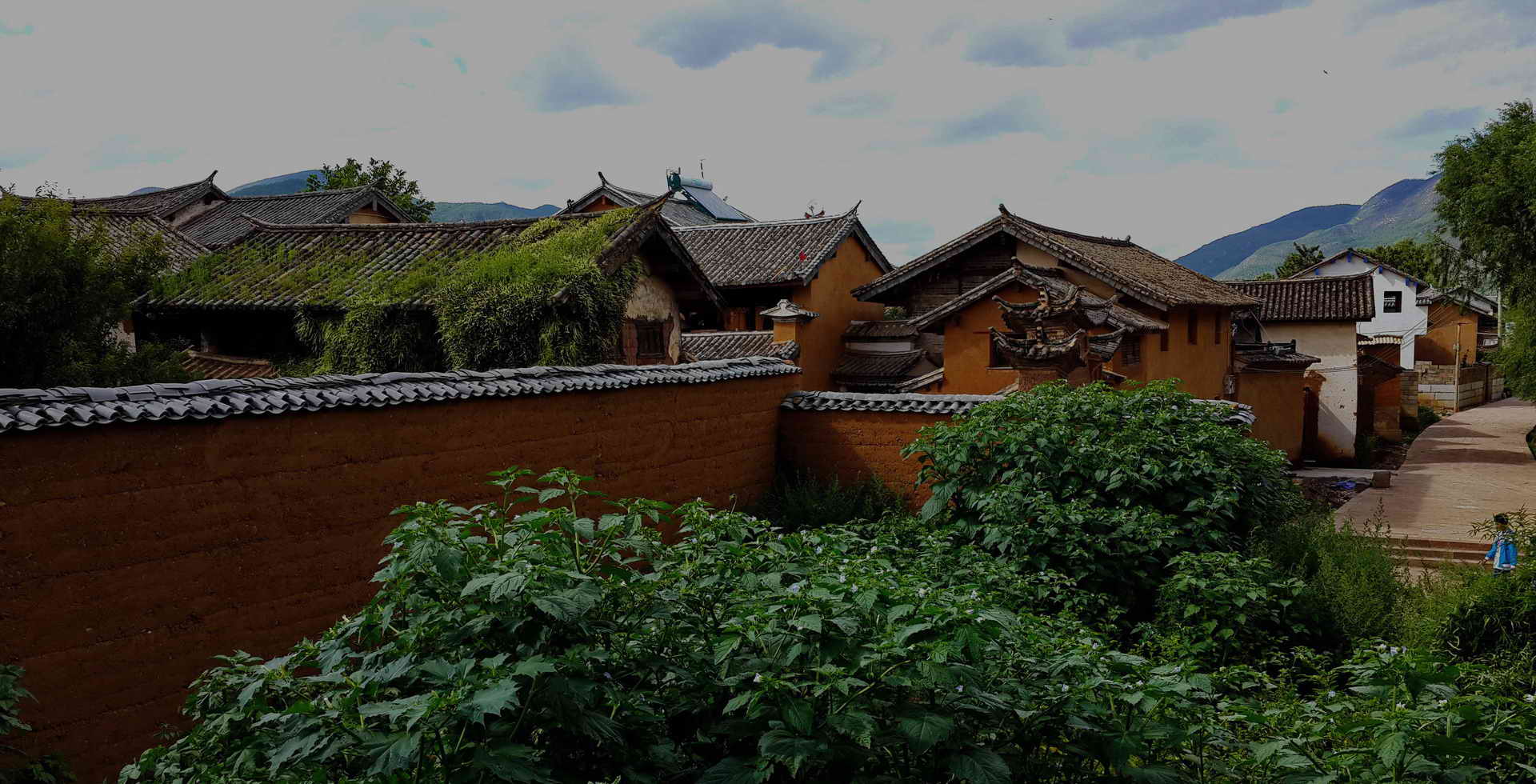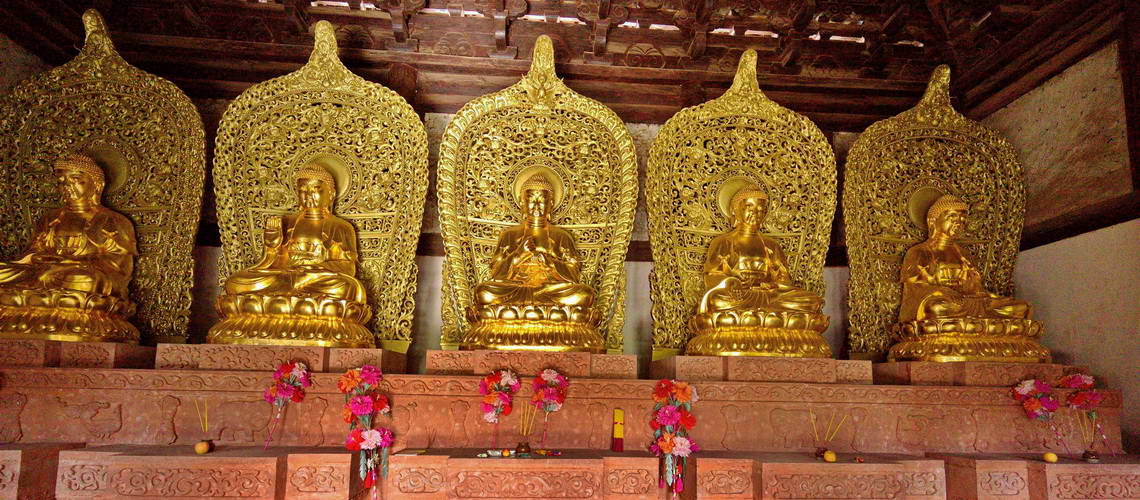
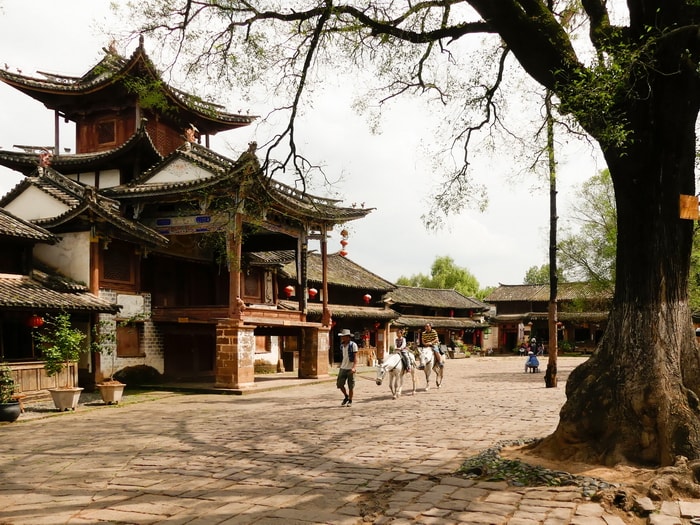
The heart of Shaxi ancient town
Very much a time capsule, Sideng Village remains a fascinating window onto a China that has long disappeared in the rest of the country. While some cafes and souvenier shops have sprung up around the main square in recent years, Sideng looks much like it did throughout its history, with peddlers, horsemen and local residents going about daily life. Ornate compound gates and entrance passages lead to courtyard microcosms of Bai home-life that have sometimes barely changed in the last forty centuries. Many of what were once tack shops, blacksmiths and caravanserais have already been converted into guest houses and souvenir stores, while others maintain their original function as homes to people and animals alike. Rammed earth and gravity defying eaves guide visitors down narrow alleys, where prickly pear cacti are a natural precursor to tall barbed wire fences, and sinuous bougainvillea splash the earthen tones with explosions of purple blooms.
The centuries old theatre temple dominates the square, though unlike its neighbor in Duan Village's Old Theatre Inn, it is rarely open to visitors. During festivals, ancient music ensembles and opera troupes will perform here and the stage makes a beautiful backdrop for photos. We recommend a half day just to explore the old street leading to the square and adjacent alleyways, where new businesses are opening every few months.
At its peak as a market area during the tea horse caravans, Sideng Square was a constantly bustling exchange, with merchants, inkeepers, horsemen and entertainers creating a thriving commercial space. Today, Sideng is mostly quiet, though there are still the occasional horses for tourists to ride and shops have sprung up since the square's rehabilitation in the early 2000's. There are guesthouses, cafes, restaurants and souvenir shops, many still run by local people. A massive Chinese scholar tree dominates the square and a timber pole which is decorated and then burned during the Shaxi Torch Festival.
Recommendations
Standing under the ancient tree, to the East is the theatre temple and stage. During festivals, there is traditional music performance and sining by local people, though the rest of the time the temple is not in use. Opposite the temple is Xingjiao Si (兴教寺), the Temple of Educational Happiness, which now functions as a museum. Tickets are 20 yuan per person at the gate.
For coffee, there are two choices: the Old Three Cafe (CLOSED?) next to the theatre stage, or Sloth Coffee, which is on South Tibet Alley just off the Southwest corner of the square. Old Tree has outdoor seating and is good for people-watching, whereas Sloth is tucked away down the alley and quieter.
For bars we recommend Old Street Bar, just down from the temple. It has local beer and some Chinese and homemade wines. Secret tatami room upstairs (take your shoes off first).
For a simple lunch, Jia Jia is a local favorite, located just up the old street (follow the flowing stream away from the square about 30m). Another favorite is Wood Fish on the South corner of the square where it joins South Tibet Alley. Very good western cooking here but not always open. Also the recently re-opened Orange is just around the corner up the old street, next to 58 Yard. Excellent local food. There is a very good jewelry seller on the South end of the square, and a silversmith just next door. More bars and simple restaurants have recently opened on the square (as of September 2019), so more reviews will be coming!
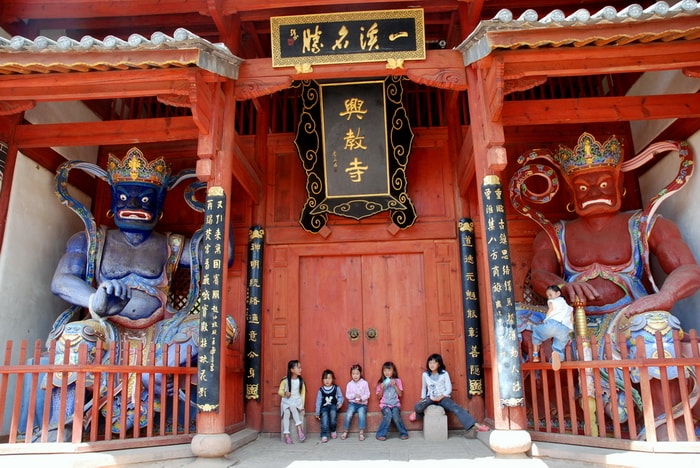
Unique in the fact that iconography from each the major Asian faiths are all featured here, this is also one of the best preserved temples in the whole country. Originally constructed as an Azhali Buddhist shrine in 1415, during the Ming Dynasty, the courtyard buildings were commandeered and used as a local government headquarters during the twentieth century's Cultural Revolution. Ironically, this saved it from the widespread destruction that befell many other traditional places of worship. The painstaking restoration process of the SRP has ensured that this site became a must see site on the Tea Horse Tourist Trail. Valuable Chinese medicine trees such as Delavay's Magnolia and the Chinese Privet thrive in shaded courtyards. Cleansed of the soot that actually protected them during more turbulent times, original murals can still be seen on the walls of the Hall of the Heavenly King, and the intricately interlocking beams of the interior ceilings are breath taking in their complexity. At the rear, in the temple building itself, five of the most beautiful golden Buddhas sit serenely beneath ornately carved auras. Without doubt these are some of the most aesthetically pleasing deities that you will see in any Chinese temple today.
The lower courtyards currently hold displays of the SRP's long term action plans for the valley, along with the highly detailed botanical illustrations of acclaimed English artist Caroline Frances-King, showing local medicinal herbs in glorious full color. Directly opposite the temple is an equally impressive open air theater stage, with an exquisite dragon and phoenix ceiling mural. On the very top floor is a shrine to the 'Kuixing' deity, similar but slightly less impressive than the portrayal in the Duan Village Temple Theater The building is also home to a tiny Chamagudao Exhibition, which is really still a work in progress, but already has some impressive examples of local woodcarving skills.
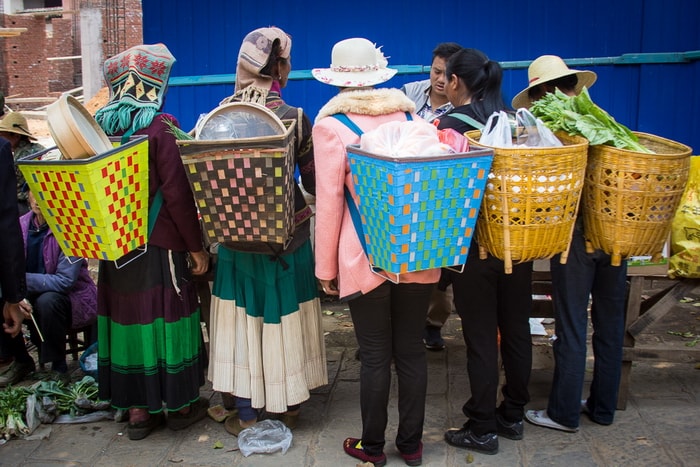
Market day is the highlight of the week in Shaxi valley, when everybody congregates in the old town to stock up on produce and exchange gossip. Rows of traditionally dressed Bai matriarchs squeeze together along the kerbside to offer a wide range of local fruit and vegetables, grown with their very own green thumbs. Yi womenfolk in bright scarlet and bold turquoise, trek for hours down from their mountain villages to trade with the lowlanders, making for one of the most colorful and photogenic market days in Yunnan. To the left of the main street is the meat market, where you can find freshly made goats cheese, cow bells and craftsman made horse tackle. In the wet market, on the right hand side, visitors can find a whole range of unusual local fruit and veg, from skirret and lotus bulbs, to quince and custard apples. Traveling vendors fill the main street, hawking everything from farm tools to fruit trees. Look out for wig makers that buy hair by the kilo (cut and weighed in situ), pavement dentists, and itinerant Han Chinese cheapjacks trying desperately to flog the latest in labor saving devices. Up beyond the minibuses, do not forget to check out the livestock market where piglets, nanny goats and even water buffalo are all available for inspection and purchase. Do not forget to stock up with apples and carrots, as this will ensure that you will quickly be able to make fast friends with any goats, donkeys and ponies that you encounter while out hiking.
At one time the small square was home to a bustling market nearly every day of the week, but this has now been relocated to the new part of town, and the ancient flag stones that surround the central pagoda tree are encouraging a new community of hikers, history buffs and eco-tourists. In the last century, Shaxi's Sideng market went from thriving economic center to a remote and inaccessible ghost town, but this national landmark is now undergoing a twenty-first century renaissance, and promises to become one of the most impressive attractions in all of Yunnan. Out beyond the East Gate is the ancient Yujin Bridge, a long time favorite of visiting artists and a vital crossing point in this complex network of ancient trade routes. Its classic humpback construction makes it an ever popular photo opportunity with visitors.
For more information, contact Sam at Old Theatre Inn.
Insider's Tours
For those coming from Baisha, Lijiang or Shuhe, we recommend Insiders Experience to bring you down to Shaxi by vintage vehicle and see the area in a totally unique way.
From Insider's website: Your
Insider will meet you at your hotel before you hop into one of our vintage jeeps and start cruising local roads crossing the outskirts of the Jade Dragon Snow Mountain. Pause for panoramic views
of the Yangtze River and the surrounding mountain ranges from the Temple of the Clouds. Further down the road to Shaxi traffic has come to a standstill near Jiuhe village as locals have set up a
roadside market providing great photo opportunities (weekends only).
Nowadays it remains rather peaceful on the cobbled streets of Shaxi but during the heydays of the Old Tea Horse Road the place was teeming with life. If today coincides with a Friday, you are in for a treat. On this day the town awakes from hibernation as neighboring Yi and Bai minorities come to sell and buy their produce: women still dress in their colorful traditional outfits and men will often lead pack mules carrying supplies back to their villages in the mountains, just as in the heydays of the old tea horse road. Visit Shibaoshan with its multi- religious shrines prior to taking the newly built highway back to Baisha; your Insider will drop you off at your hotel in Baisha, Shuhe or Lijiang after.
For more information on Insiders tours of Shaxi Friday Market, please contact them directly here.
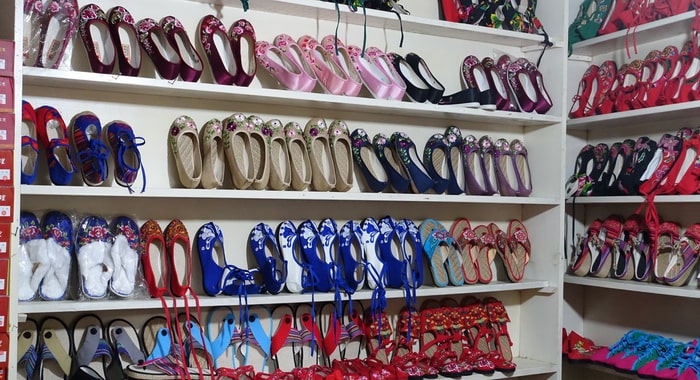
Zhao family handmade shoes
If you're looking for Shaxi handicrafts, start in old town at the Zhao family shoemaker shop. These are finely embroidered silk and cotton shoes still worn for traditional dance and ceremonies in Shaxi. The handmade shoes are reasonably priced and can also be made to order. Find the Zhao family shoes halfway down the main street in Shaxi old town on the left side. In addition to shoes, the Zhao's also make a number of other Shaxi handicrafts such as children's toys and decorative wall hangings.
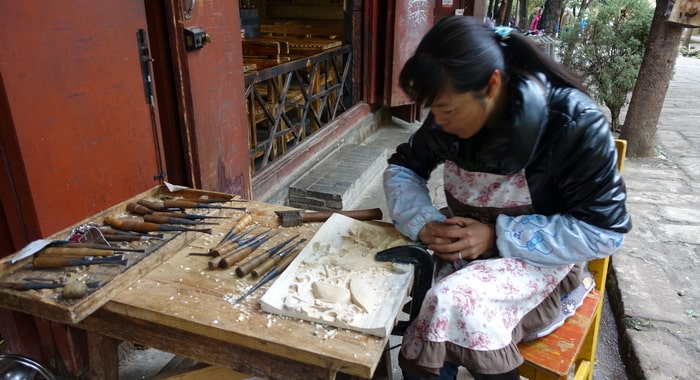
Traditional woodcarving
The Yang family offer Shaxi woodcarving gifts in Shaxi old town. You can often find Mrs. Yang in the process of making these woodcarvings outside her shop. These consist of small lacquered panels for framing, statues of gods and heroes, and other small decorative itmes. These traditional Shaxi woodcarving pieces make very nice gifts and are easy to pack and take home with you.

Xiao Cai handmade jewelry
Xiao Cai is a young woman from Northeast China who settled in Shaxi several years ago. Since then, she has been making beautiful original jewlery in her Sideng Square shop. In addition to jewelry,
she also sells handmade clothing and vintage fabrics.
FIND HER: Facing the old theatre temple in Sideng Square, the jewelry shop is over your right shoulder, on the South corner of the square
before Woodfish restaurant and South Tibet Alley.
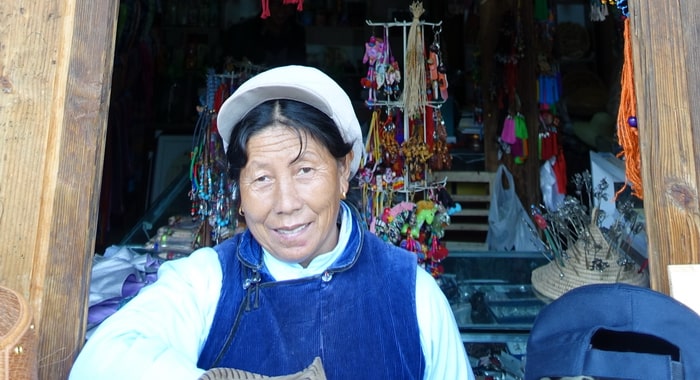
Traditional handicrafts
Located next to the theatre stage in Sideng Square is a great Shaxi handicraft shop with a wide selection of authentic handmade gifts. The shop is run by the local Zhao family who have resisted renting
out for a higher price to non-local Chinese and they are one of the few Shaxi handicraft shops in the old town.
FIND IT: Facing the old theatre temple in Sideng Square, the handicraft shop
is immediately on the left, before Horsepen 46 hostel.
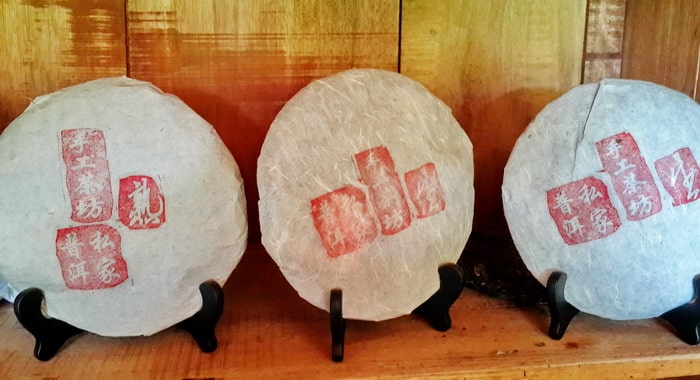
Handmade teas
Ah Ping is a young man from the town of Bao Shan, a tea making district in Eastern Yunnan. Working 11 years in a tea factory there, Ah Ping learned much about the art of Yunnan Puer tea making. He
has set up a shop in Shaxi Old Town where he demonstrates the ancient art of hand pressing Yunnan Puer tea. His shop is intimate and he has a tasting room upstairs. Visitors can choose from various
sizes and varieties of Yunnan Puer tea cakes, some shaped like mushrooms and bells. Yunnan Puer tea makes a great gift for tea lovers, and there's no better place to buy freshly pressed cakes
than Ah Ping's shop.
FIND IT: His shop is located just to the left of Shaxi Xing Jiao temple in Sideng Square.
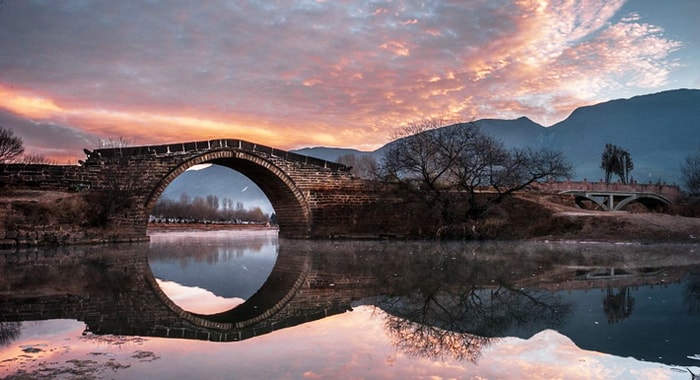
The meandering Heihui River runs through Shaxi from north to south. Opposite the East Gate of Shaxi Old Town spans the ancient Yujin stone arch bridge. Yujin Bridge was built in the Qing Dynasty during the reign of Emperor Kangxi (1654-1722). For centuries the bridge brought horse caravans over the river to and from Eryuan and Dali. Ensuing years of civil war and neglect took their toll on the bridge which collapsed in the 1920s. In 1931, Jianchuan County held public fundraising to rebuild the iconic bridge, and famous Bai scholar Zhao Fan campaigned personally for "bridge repair offerings". Yujin Bridge arch spans 12 meters, 6 meters high, 5 meters wide, with stone pillars and stone ramparts. There is a stone turtle head vault, and a giant salamander stone. The ancient bridge is a living monument to generations of Shaxi people who have relied on it to bring their produce to market and tend their fields.
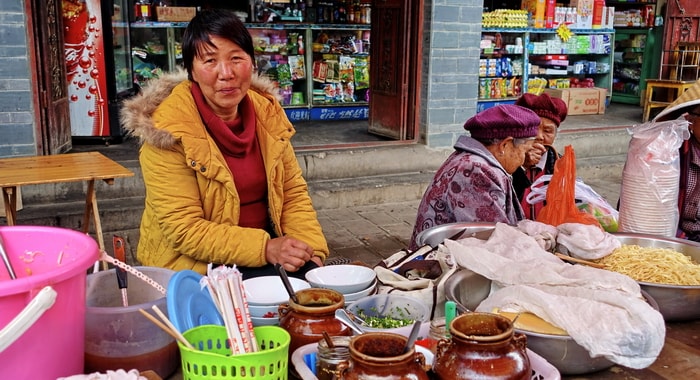
While in town, you will find many small restaurants as well as hawkers selling cold noodles, toufu, candied nuts and assorted fare. Please see our list of recommended street food vendors
on our Shaxi restaurants page
With so much fresh fare to choose from, even the simplest of Shaxi offerings
are streets ahead of their big city counterparts. Everyday dishes such as tomato and eggs boast a natural, organic flavor that urban eateries just cannot match. For most Bai, pork is
the main meat of the diet, and it is very common to encounter hams and sausages, as well as smoked liver and smoked intestines. The growth of fish farms in the valley has meant that the
traditional stewed carp casserole has made a resurgence in recent years. Served locally with enough spice to power a NASA deep space mission, milder versions, are often made available
for overly-sensitive tourists.
Rubing, (known locally as youdbap in the Bai dialect) is a delicate goat's cheese, very similar in taste and texture to queso blanco in South America
or paneer in India. While it is usually served fried with a honey or sugar dip, more adventurous travelers might want to try a fermented rice dish topped with slices of cheese, known
as 'jiu mi he rubing'. The only way that I can describe it, is as a super-rich, alcohol-infused rice pudding, with hefty slabs of fried feta on the top, which is even more delicious than
it sounds.
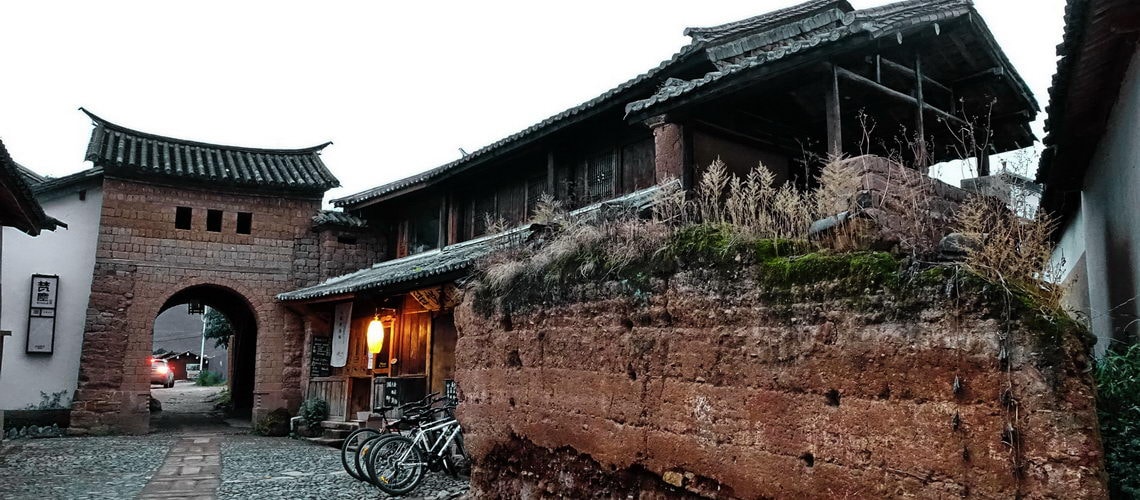
Old Town Accommodation Between five and ten new guest houses are opening every year in Sideng Village, but already a number of front runners are emerging as the most popular choices. Laomadian (literally 'Old horse Inn) is owned by a Taiwanese investor, who has also restored impressive properties in Lijiang and Shangri La. Rooms
here remain as authentic as possible (albeit with modern bathrooms) to the original caravanserai that also now doubles as a restaurant, with quality food being served to discerning tourists.
The 18 rooms in the updated courtyard, give a feeling of a typical local home.
Tucked away around the corner from the Temple Stage is the ever popular Horse Pen 46 youth hostel. The stalls around the courtyard have been converted into a selection of dorms and simple rooms, and have quickly become famous for their soft comfy beds, despite being a
little spartan otherwise. The English speaking owner, Shirley is a mine of local information and can organize everything from rock climbing to river rafting. She is assisted by three
lovable canines who will quickly change your opinion about Chinese dogs. Ask about the guided hikes that are organized by the owners every Saturday. Just up the Alley from the square
is the Number 58 Yard Hostel, slightly more oriented to
domestic tourists, but comfortable and welcoming all the same. Again there are dorms as well as private rooms and a large deck area above the courtyard, that is great for socializing
in the evenings. Even if you do not stay here, be sure to try the beautifully presented matsutake mushroom fried rice for lunch

